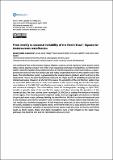Por favor, use este identificador para citar o enlazar a este item:
http://hdl.handle.net/10261/270332COMPARTIR / EXPORTAR:
 SHARE
BASE SHARE
BASE
|
|
| Visualizar otros formatos: MARC | Dublin Core | RDF | ORE | MODS | METS | DIDL | DATACITE | |

| Título: | From weekly to seasonal variability of the North Brazil - Equatorial Undercurrent retroflection |
Autor: | Vallès Casanova, Ignasi Berenguer CSIC ORCID ; Pelegrí, Josep Lluís CSIC ORCID ; Martín-Rey, Marta CSIC ORCID; van Sebille, Erik; Olivé Abelló, Anna CSIC ORCID | Fecha de publicación: | 27-abr-2021 | Editor: | European Geosciences Union | Citación: | European Geosciences Union General Assembly (2021) | Resumen: | The northward flow in the western tropical Atlantic Ocean is carried mainly by North Brazil Current (NBC), hence playing a major role in the cross-equatorial exchange of properties. As thermocline waters reach the equator, they largely retroflect to feed the Equatorial Undercurrent (EUC), a quasi-permanent zonal current that brings salty and highly-oxygenated waters to the eastern side of the basin. This retroflection system is governed by the zonal pressure gradient, which is driven by the trade winds. Hence, the wind fluctuations represent the major source of variability at seasonal and interannual scales. However, at shorter time scales, the variability of the retroflection system may be associated with both interior and coastal waves. In the present study we describe the water mass balance at the NBC-EUC retroflection area using a combination of shipboard observations and numerical reanalysis. The observations, from an oceanographic campaign in April 2010, provide a synoptic view of the retroflection region and allow assessing the goodness of the numerical data. We then use the ocean reanalysis GLORYS2v4 to analyse the temporal variability of this region, from intra-seasonal to seasonal scales, and use Lagrangian simulations to identify the principal water mass pathways feeding the retroflection. We find a substantial seasonal cycle in the boundary and interior (southern and northern) origins of those waters that feed the EUC. Our results also show the propagation of high-frequency waves (16-30 days) along the coast from the south, probably as coastal trapped waves, while waves with 30-60 days period come from the northern hemisphere, probably as westward Rossby waves reach the coast of America and follow south as Kelvin waves. These short-term fluctuations have a high impact on the water mass pathways that feed the EUC and the retroflection structure itself | Descripción: | European Geosciences Union (EGU) General Assembly, 19-30 Apr 2021.-- 1 page, supplementary material https://vimeo.com/user112509113 | Versión del editor: | https://doi.org/10.5194/egusphere-egu21-13045 | URI: | http://hdl.handle.net/10261/270332 | DOI: | 10.5194/egusphere-egu21-13045 |
| Aparece en las colecciones: | (ICM) Comunicaciones congresos |
Ficheros en este ítem:
| Fichero | Descripción | Tamaño | Formato | |
|---|---|---|---|---|
| Valles_et_al_2021.pdf | 277,95 kB | Adobe PDF |  Visualizar/Abrir | |
| Valles_et_al_2021_poster.pdf | 3,4 MB | Adobe PDF |  Visualizar/Abrir |
CORE Recommender
Page view(s)
42
checked on 05-may-2024
Download(s)
43
checked on 05-may-2024
Google ScholarTM
Check
Altmetric
Altmetric
Este item está licenciado bajo una Licencia Creative Commons

